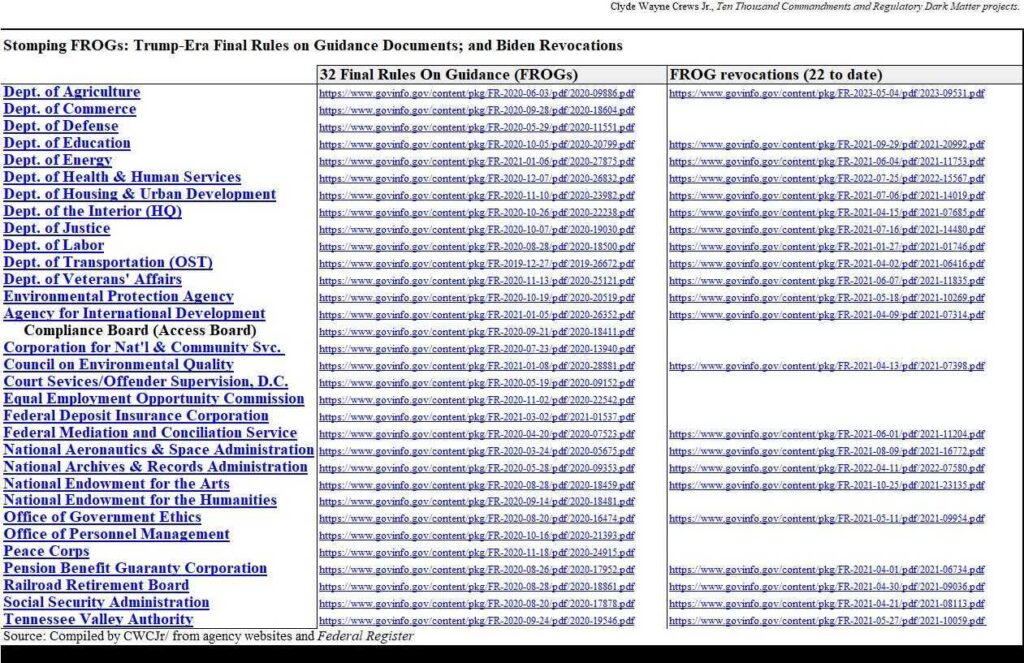Biden administration keeps making it harder to track government ‘guidance’ documents

Photo Credit: Getty
Federal government “guidance documents” consist of agency memoranda, bulletins, circulars, administrative interpretations, letters, manuals, and so much more. These are not supposed to be regulatory pronouncements, but critics charge these documents often have regulatory effects.
Legislation has been introduced to address this problem. See for example the “Guidance Out of Darkness Act” (a.k.a. “GOOD Act). Its origins are bipartisan, dating back to the 115th Congress.
As the GOOD Act recognized with its requirement for a one-stop portal for guidance documents, sometimes these government releases are hard to even locate. Former President Donald Trump sought to address that concern and potential abuse of guidance documents in 2019’s Executive Order 13891, “Promoting the Rule of Law through Improved Agency Guidance Documents.”
This move established online portals and inventories at agency websites.But thatexecutive order was eliminated by Joe Biden—on his very first day in office. Agencies promptly pulled down the portals.
Nonetheless, a count derived from my own August 2022 survey of agency portal remnants topped 107,000 entries. (I maintain a post-Trump unofficial portal here)
That tally is not all-encompassing by any means, but it wouldn’t have been possible without Trump’s order. We can know this because, in 2018, the House Oversight and Government Reform Committee, in its report called Shining Light on Regulatory Dark Matter, had been able to pressure resistant agencies to scrounge up only 13,000 guidance documents.
The lesson there is congressional overseers need to keep the utility of portals and disclosure uppermost in mind. They provide needed information to the public about often confusing federal matters that affect them directly.
Public protections against potential abuse of guidance has deteriorated under Biden in another way.
In addition to the portals, Trump’s E.O., required that agencies issue rulemakings setting out their procedures for preparation, disclosure and public protections with respect to the guidance documents they issue.
Trump’s E.O. came near the end of his term, so not every department and agency issued one of these “final rules on guidance.” (FROGS, as I call them.) As the figure below shows, (click here to examine the links to the rulemakings depicted), 32 departments and agencies issued and adopted these procedures until the Trump departure and Biden revocation made the preparation of these public-protection rulemakings a moot point.

It is rather shocking to realize that, at Biden’s behest, agencies literally set about writing new rules to disavow and eliminate their guidance disclosures and procedures.
Some bureaus turned on a dime to repudiate their own guidance-on-guidance. Others took and are taking their time. I got curious about where things stand, so searched for rulemaking actions on this subject. At this point, there have been revocations of guidance document procedures by at least 22 departments and agencies, as also depicted in the figure nearby.
Biden’s repudiation of the Trump agenda of regulatory cost freezes and streamlining has been thorough and extends well beyond guidance documents, as documented elsewhere. Some of the same agencies doing an about-face on guidance published plans in the “Unified Agenda on Federal Regulatory and Deregulatory Actions” revealing an inflexible intent to regulate more than deregulate despite the “one-in, two-out” directives of the era. So Biden didn’t really need to twist arms here.
Despite the surge in legislation and federal expansions of the past three years, assessments of derivative regulatory interventions seem destined to publicly reveal even less. Those concerns may lead to new outcry over regulatory excess. If that happens, there may yet again be bipartisan demand for disclosure and reform.